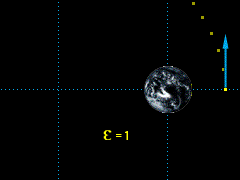| Ch 2. Particle Force and Acceleration | Multimedia Engineering Dynamics | ||||||
|
Rect. Coord. |
Normal/Tang. Coord. |
Polar Coord. |
Orbital Mechanics | Computational Mechanics | |||
| Orbital Mechanics | Case Intro | Theory | Case Solution | Example |
| Chapter |
| - Particle - |
| 1. General Motion |
| 2. Force & Accel. |
| 3. Energy |
| 4. Momentum |
| - Rigid Body - |
| 5. General Motion |
| 6. Force & Accel. |
| 7. Energy |
| 8. Momentum |
| 9. 3-D Motion |
| 10. Vibrations |
| Appendix |
| Basic Math |
| Units |
| Basic Dynamics Eqs |
| Sections |
| eBooks |
| Dynamics |
| Fluids |
| Math |
| Mechanics |
| Statics |
| Thermodynamics |
| ©Kurt Gramoll |
|
|
||
| Solution of a) |
||
 Circular Orbit, ε = 0 |
The initial velocity required to give the satellite a circular orbit can be found from, = 16,300 ft/s |
|
| Solution of b) |
||
 Parabolic Orbit, ε =1 |
The minimum initial velocity required to escape the earth's gravitational pull can be found from: = 23.1 x 103 ft/s |
|
| Solution of c) |
||
|
|
To find the maximum radius, the eccentricity of the orbit must be determined when the initial velocity of the satellite is 20,000 ft/sec. = 0.500 Because 0 < ε < 1, the orbit must be elliptical, and thus the maximum radius occurs at apogee. = 158 x 106 ft = 29,900 miles |
|




